Navigating Modern Construction Challenges
Construction projects today are more complex and demanding than ever before. With rising material costs, tighter deadlines, and increasingly intricate client requirements, builders must operate with precision and efficiency. Success lies in achieving the perfect balance between speed and quality ensuring each structure is not only delivered on time but is also safe, durable, and built to last.
Whether it’s a modest home extension or a large-scale commercial development, thorough planning remains the cornerstone of every successful project. Skilled labor, cutting-edge machinery, and high-quality materials work together to ensure smooth execution within budget. In today’s ever-evolving landscape, only the most adaptive construction firms continue to thrive.
Embracing Modern Construction Techniques

Innovative methods are revolutionizing how buildings are designed and constructed. Prefabricated concrete panels and modular systems streamline the process, significantly reducing on-site construction time while maintaining structural integrity. Meanwhile, advanced machinery such as automated brick-laying robots is boosting productivity and minimizing the risk of human error.
Digital tools are also playing a critical role. Technologies like 3D modeling and Building Information Modeling (BIM) enable better project coordination, real-time problem-solving, and precise planning. These advancements not only reduce waste and cut costs but also help avoid delays making modern techniques essential in today’s competitive construction industry.
Steps to Build Sustainably
These innovations help reduce waste, lower costs, and minimize project delays. If you want to build a greener project, follow these steps:
- Plan with sustainability in mind
- Select certified green materials
- Hire skilled eco-conscious contractors
- Reduce waste during construction
- Use smart home technology for efficiency
The Future of Construction
Looking forward, construction will continue to grow smarter and more sustainable. Green materials, energy-efficient designs, and smart building systems will shape the way we live and work in the next decade. Safety will also remain a top priority, with stricter standards and advanced protective equipment keeping workers secure on-site. At the same time, construction companies will need to invest in skilled labor and technology to stay competitive in a rapidly changing market. With collaboration, innovation, and a focus on quality, the future of construction looks.
“Great buildings aren’t just made of bricks and steel — they’re built on trust, teamwork, and a clear vision.”
Meeting the Demands of Modern Construction
Today’s construction projects are more complex than ever, facing pressures from rising material costs, tighter schedules, and evolving client expectations. Builders must strike a careful balance delivering projects quickly while ensuring that every structure is safe, long-lasting, and built to the highest standards.
Whether it’s a small residential addition or a large commercial development, success begins with smart planning. Skilled teams, advanced equipment, and quality materials all play a vital role in completing projects on time and within budget. In this rapidly shifting industry, the most successful construction firms are those that adapt and innovate.
Innovative Design for Sustainable Building
Modern construction goes beyond strength it also considers health, efficiency, and environmental impact. Here are a few smart design choices shaping sustainable building today:
- Use low-VOC paints to improve indoor air quality and reduce chemical exposure
- Install green roofing to manage storm water and reduce heat absorption
- Optimize for energy-efficient windows to regulate indoor temperatures and reduce energy use
- Design site orientation to take advantage of natural sunlight and minimize artificial lighting
- Incorporate rainwater harvesting systems for sustainable landscape irrigation
These innovations not only enhance building performance but also support long-term environmental responsibility.
Why Sustainable Construction Matters

New technologies are making sustainable construction more practical than ever. Builders can now source recycled materials that maintain the strength and durability of traditional supplies while dramatically lowering their environmental impact. Smart building systems, like automated lighting and energy-efficient HVAC, help reduce power consumption without sacrificing comfort.
Innovations in insulation, window glazing, and roofing systems also play a vital role in keeping buildings thermally efficient. Even site planning has evolved to optimize natural sunlight and airflow, cutting down the need for artificial heating or cooling. All of these features come together to make sustainable construction.
1. Maintain Proper Drainage
Water is one of the biggest threats to any foundation. If water pools around your home, it can seep into the soil, causing it to expand and put pressure on the structure. Over time, this can lead to cracks and settlement. Make sure your gutters are clean, downspouts extend far enough, and the yard slopes away from the foundation to protect your home. Even if your foundation seems solid, problems can hide beneath the surface. Hiring a qualified inspector every few years can reveal early warning signs of settlement, moisture damage, or shifting that you might miss. Investing in inspections today can save you from major structural.
2. Repair Cracks Early
Small cracks may seem harmless, but they can quickly grow into much larger structural problems if ignored. Regularly inspect your foundation for visible cracks or shifting, and seal them as soon as possible. Early repairs are far more affordable than a full foundation rebuild down the line. Before you build or renovate, it’s essential to understand what kind of soil supports your foundation. Some soils expand or shrink dramatically with moisture, putting stress on the structure. Compacted, tested soil with good bearing capacity will prevent shifting and sinking, ensuring a long-lasting foundation.
3. Use Quality Materials
The strength of your foundation starts with the quality of its materials. Always choose high-grade concrete and strong steel reinforcement to avoid weak spots or premature failure. Cheap or poorly mixed materials might save money upfront but can cost you far more in repairs later. Before you build or renovate, it’s essential to understand what kind of soil supports your foundation. Some soils expand or shrink dramatically with moisture, putting stress on the structure.
Conclusion
Safeguarding your home’s foundation is one of the wisest decisions you can make as a homeowner. Simple actions like ensuring proper drainage, repairing cracks early, and scheduling routine inspections can prevent costly damage and preserve your home’s structural integrity for years to come.
A strong foundation not only holds up your home but also protects your peace of mind. By using high-quality materials and partnering with experienced professionals, you're investing in long-term strength and security.




